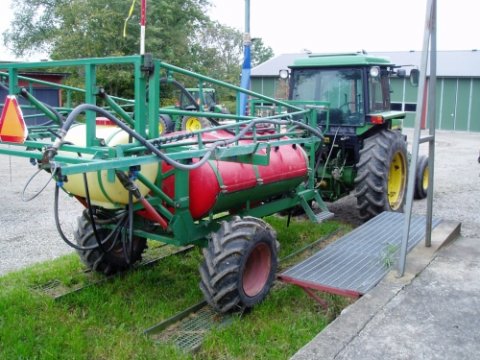Unsatisfactory management of pesticides and other chemicals can give rise to residues in surface and groundwater. Several field surveys and measurement campaigns on catchment scale have demonstrated that 40 to 90% of surface water contamination by pesticides is attributed to direct losses. The main direct losses are spillages resulting from the filling operation, leakages of the spray equipment, spray leftovers and technical rest volumes in the tank, pump and booms, rinsing water from cleaning the internal tank to avoid carry over effects (damage and residues) onto the following crop, water from external cleaning of spray equipment, etc.
Examples of point-source contamination:
Pictures form the TOPPS project.
Physico-chemical waste water treatments discussed are very effective, but in most cases too expensive for average farmers. Therefore some form of biological processing is usually the preferred method for the treatment of effluents containing pesticides. For agricultural purpose these treatment systems need to be cheap and reliable, easy to use with low labor and time input and low waste disposal cost. A possible approach is the use of biopurification systems to capture and treat contaminated water from the farmyard and/or spillages from the filling process.
The biopurification system has generated interest in various countries all over the world.
Number of biobeds in the world:
Its implementations has sometimes led to modifications of the original Swedish design, called the biobed. After the development of this system, variations to it have been made and are called Phytobac®,biofilter, biomassbed, etc.. The concept of these three systems is similar. They all consist of a biological active matrix which retains the pesticides onto organic matter or soil particles, where enhanced or rapid microbial degradation of the pesticides occurs. A schematic representation of the different systems is presented:
A scematic presentation
A few pratical biopurification system set-ups are presented here:

Biobed Foto: Jens Husby
Biofilter Foto: Tineke De Wilde

Biomassbed Foto: Federico
Ferrari

Phytobac Foto: Bayer CropScience
The first reported substratum mix used in bioremediation systems consisted of peat, straw and topsoil. These compounds were originally mixed in volumetric proportions of 1:2:1 respectively, and is called biomix. Various studies investigate the use of alternative substratums. Starting from the original biomix, various primary substratums have been mixed for biopurification purposes, both in laboratory studies and in pilot installations. Alternatives are several agriculture waste by-products, such as vine branch, green waste compost, urban waste compost, manure, etc
Biobeds in Latin America
The inexpensiveness, simplicity and efficiency of the biobed system make it suitable for application in developing countries. One important difference is the often smaller size of farms in developing countries compared with European farms. Therefore, a small biobed for a person standing and filling a backpack sprayer is often sufficient. Adaptation of the biobeds to tha particular conditions of the country are being made, among others, in Guatemala and Chile.